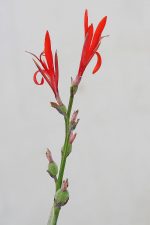 Indian shot is a herbaceous perennial and a member of the Cannaeceae family that is most closely related to ginger, banana, and bird of paradise. It is native to the West Indies and tropical American, maybe including areas in the South, where it grows in moist areas such as wetland edges and along stream banks. Plants grow 3-6′ tall from a rhizomatous rootstock and have fleshy, stout unbranched stems sheathed by leaves that are bronze to green and up to 20″ long and 8″ wide. The 2-3″ wide flowers appear in late summer in stiffly erect terminal racemes and are are red, or sometimes red and yellow, and sometimes with spots. The flowers give way to papery seed capsules filled with black round or egg shaped seeds that resemble shot gun pellets, hence the common name. The generic name Canna comes from the Greek word kanna meaning reed. The specific epithet, indica, refers to the India or the West Indies, the latter being an original home of the plant. The roots of indian shot have been a source of food in the Americas for thousands of year. The plants are a good choice for containers and tropical gardens.
Indian shot is a herbaceous perennial and a member of the Cannaeceae family that is most closely related to ginger, banana, and bird of paradise. It is native to the West Indies and tropical American, maybe including areas in the South, where it grows in moist areas such as wetland edges and along stream banks. Plants grow 3-6′ tall from a rhizomatous rootstock and have fleshy, stout unbranched stems sheathed by leaves that are bronze to green and up to 20″ long and 8″ wide. The 2-3″ wide flowers appear in late summer in stiffly erect terminal racemes and are are red, or sometimes red and yellow, and sometimes with spots. The flowers give way to papery seed capsules filled with black round or egg shaped seeds that resemble shot gun pellets, hence the common name. The generic name Canna comes from the Greek word kanna meaning reed. The specific epithet, indica, refers to the India or the West Indies, the latter being an original home of the plant. The roots of indian shot have been a source of food in the Americas for thousands of year. The plants are a good choice for containers and tropical gardens.
Type: Herbaceous perennial
Bloom: Red, or red and yellow, sometimes speckled flowers in late summer
Size: 3-6′ H x 2-3′ W
Light:Full sun
Soil:Fertile, moist, well-drained
Hardiness: Zones 8-10
Care: Deadhead, fertilize
Pests and Diseases: Slugs
Propagation: Division, seed
Companion Plants:Gunnera, elephant ear, hibiscus
Outstanding Selections: ‘Purpurea’ (purple flushed leaves)
Photo Credit: Muhammad Mahdi Karim Wikipedia